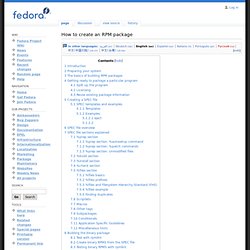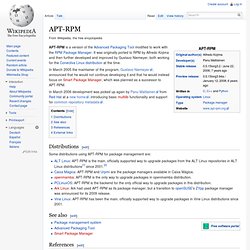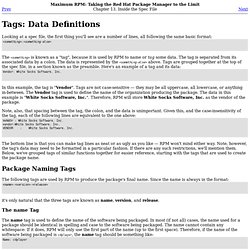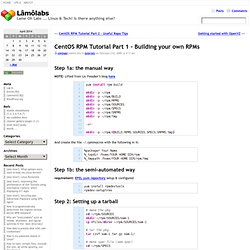

AdditionalResources/Repositories/RPMForge. RPMforge is a collaboration of Dag and other packagers.

They provide over 5000 packages for CentOS, including wine, vlc, mplayer, xmms-mp3, and other popular media tools. It is not part of Red Hat or CentOS but is designed to work with those distributions. See also Using RPMforge and Repoforge. Note: Because this repository is NOT part of CentOS, you should direct support questions to its maintainers at the Repoforge Users mailing list. Packages are supplied in RPM format and in most cases are ready to use. 1.
The default RPMforge repository does not replace any CentOS base packages. You can find a complete listing of the RPMforge package packages at Download the rpmforge-release package. GNU/Linux - Roll Your Own RPM. Subject Building from source is fun, but it's easier to distribute RPMs to a bunch of machines.

You may recall that we recently built and installed the OpenTDS libraries and SQSH, a dandy little command line tool for use with MS SQLServer. These built nicely on my RedHat 7.3 system, and I have a bunch of other developer workstations running the same OS. So let's roll these tools into a couple of RPMS for easy distribution. First, I must refer you to the excellent RPM HOWTO and its section on building RPMS. Basically, when we build an RPM, we're scripting a source build and install. The Spec File All of the customizations mentioned above are defined in the spec file, which we will put in /usr/src/redhat/SPECS.
The header section: The description is self-explanatory: The following sections define how the package is to be built and installed: In the files section, you must list all of the files to be included in the package. How to create an RPM package. Introduction This page describes in detail how to create an RPM package, and in particular, how to create a SPEC file.

Unlike other RPM guides, this page explains the specifics for Fedora with links to Fedora-specific guidelines. « Shadow Logs »: HOWTO: Creating your own YUM RPM repository. YUM is the default package manager provided with most RPM distros, especially Fedora and Redhat based distros. It is similar to APT of the Debian based distros. Admittedly, it is not the best package manager in term of performance, I personally feels APT is faster and easier to use. However, it do have some good points. APT-RPM. APT-RPM is a version of the Advanced Packaging Tool modified to work with the RPM Package Manager.

It was originally ported to RPM by Alfredo Kojima and then further developed and improved by Gustavo Niemeyer, both working for the Conectiva Linux distribution at the time. In March 2005 the maintainer of the program, Gustavo Niemeyer, announced that he would not continue developing it and that he would instead focus on Smart Package Manager, which was planned as a successor to APT-RPM. In March 2006 development was picked up again by Panu Matilainen from Red Hat at a new home, introducing basic multilib functionality and support for common repository metadata. Creating a Redhat Yum Repository. Although many publically available yum repositories exist, creating one's own repository can result in better access and more control over the repository.

Yum or Apt? While aficionados will heatedly argue the advantages of one over the other, it basically does not matter whether you use yum or apt. How to make deb packages - Linux For Devices Articles - Linux fo. Debian ranks as the fourth most-used distribution for embedded development, according to LinuxDevices.com's annual Embedded Linux Market Survey, with a rising rate of adoption. Developers wishing to distribute software binaries and source for use with Debian systems will want to learn the basics of... creating Debian packages (.deb's). This detailed how-to shows all the necessary components of a package and how to put them together to end up with a final product. How to make deb packages The Debian packaging system is one of the most elegant methods of installing, upgrading, and removing software available.
Błąd wczytywania strony. Deploying Django Sites using RPM. Why?

Django is a great framework for developing websites but as with most projects there isn’t a particular focus on the system administration side of running a real site. There are great instructions describing the source-level changes you’ll want to make and what you’ll need to configure your webserver to do but … what about afterwards? Setting up an RPM build environment.
Back when I started this site I was recommending that users go through the process of chown-ing chmod-ing the /usr/src/redhat folder so that it was writable by a normal user account as opposed to only root.

A few weeks back a user brought up the question of why I was doing this. Well, the answer is "it's just the way I've always done things"... When I started using Linux a decade or so ago I was taught that this was where you built rpms. Later, when told that I shouldn't be compiling as root, I simply created a new user, changed the permissions on that folder tree, and went about my business. The truth is, there's absolutely nothing wrong with this process if you're the only user of the system.
As was mentioned earlier, about a month ago, a kind user, Colin Guthrie, questioned my process. Tags: Data Definitions. Looking at a spec file, the first thing you'll see are a number of lines, all following the same basic format: The <something> is known as a "tag", because it is used by RPM to name or tag some data.

The tag is separated from its associated data by a colon. The data is represented by the <something-else> above. Tags are grouped together at the top of the spec file, in a section known as the preamble. Making a Package That Can Build Anywhere. While RPM makes building packages as easy as possible, some of the default design decisions might not work well in a particular situation.

Here are two situations where RPM's method of package building may cause problems: Either of these situations can be resolved by directing RPM to build, install, and package the software in a different area on your build system. CentOS RPM Tutorial Part 1 – Building your own RPMs « Lâmôlabs. Slmingol posted this in tutorials on February 21st, 2009, @ 4:11 am Step 1a: the manual way.

Bug 487300 – rpmbuild forces dependency on missing /usr/local/bi. How To Extract an RPM Package Without Installing It (rpm extract. As most of you may know to how extract a tarballs and/or a zip files. Someone, recently PM me with a question: